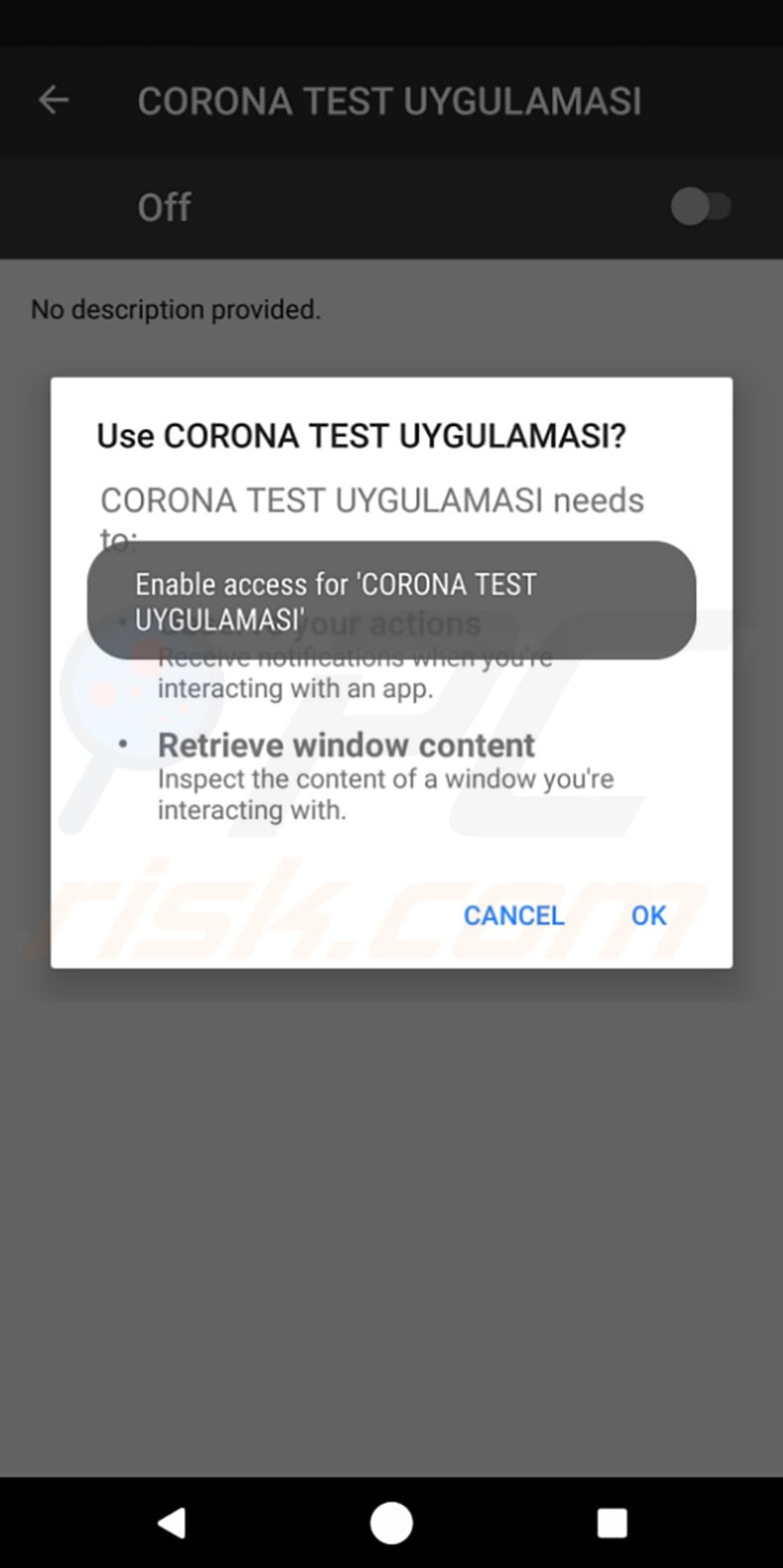Get free scan and check if your device is infected.
Remove it nowTo use full-featured product, you have to purchase a license for Combo Cleaner. Seven days free trial available. Combo Cleaner is owned and operated by RCS LT, the parent company of PCRisk.com.
What is the Anubis Trojan?
Targeting Android users, Anubis is malicious software classified as a banking Trojan. This malware attempts to steal banking information and can lead to victims' experiencing financial loss, privacy issues and other serious problems.
Anubis has been observed being proliferated via deceptive/scam websites, which incorporate the Coronavirus/COVID-19 pandemic in some manner.

Anubis malware overview
One of the scam sites used to promote Anubis is presented as an official web page, or one approved by the World Health Organization (WHO). This is implied by the genuine WHO emblem/logo emblazoned on the bottom of the page, however, this malicious website is in no way connected to WHO and is using the logo in obvious violation of publishing policy.
This emblem can only be used with express written permission, as it suggests official collaboration, involvement or approval from the World Health Organization. With the current social climate, material relating to WHO is often incorporated by scammers and cyber criminals to lure potential victims.
This allegedly WHO-approved site urges people to download a form listing life-saving methods of Coronavirus/COVID-19 prevention and protection. Another website promoting this malware similarly exploits the viral pandemic to further its goal.
It claims that to aid all operators in the fight against Coronavirus/COVID-19, the equivalent of 8 GB of mobile phone internet is offered free of charge. Users are instructed to download, install and grant an unspecified level of access to the application, after which they will receive the promised amount of data.
These web pages are scams - rather than delivering on their promises, users will unintentionally allow Anubis into their devices. This Trojan primarily targets banking information such as credit card details and other associated credentials. Anubis infections can result in financial loss, significant privacy issues and other serious problems.
Therefore, if it is known or suspected that the Anubis Trojan (or other malware) has already infected the system, you are strongly advised to eliminate it immediately.
| Name | Anubis malware |
| Threat Type | Android malware, malicious application, Trojan, banking malware. |
| Detection Names | Avast (Android:Cerberus-F [Bank]), BitDefender (Trojan.GenericKD.33540408), ESET-NOD32 (A Variant Of Android/TrojanDropper.Agent.EMX), Kaspersky (HEUR:Trojan-Dropper.AndroidOS.Hqwar.bz), Full List (VirusTotal) |
| Symptoms | The device is running slow, system settings are modified without users' permission, dubious applications appear, data and battery usage is increased significantly, browsers redirect to rogue websites, intrusive advertisements are delivered. |
| Distribution methods | Infected email attachments, malicious online advertisements, social engineering, deceptive applications, scam websites. |
| Damage | Stolen personal information (private messages, logins/passwords, etc.), decreased device performance, battery is drained quickly, decreased internet connection speed, significant data loss, monetary loss, stolen identity (malicious apps might abuse communication apps). |
| Malware Removal (Windows) |
To eliminate possible malware infections, scan your computer with legitimate antivirus software. Our security researchers recommend using Combo Cleaner. Download Combo CleanerTo use full-featured product, you have to purchase a license for Combo Cleaner. 7 days free trial available. Combo Cleaner is owned and operated by RCS LT, the parent company of PCRisk.com. |
Android-targeting malware examples
eventbot, Ginp and Cerberus are some examples of other Android-specific malware infections. While the capabilities/features of this malicious software differ, the end-goal is identical: to generate revenue for the cyber criminals behind them.
Malware is commonly disguised as legitimate, popular software, and yet it exploits the current social climate (e.g. Coronavirus/COVID-19) to ensure widespread proliferation.
How did Anubis infiltrate my device?
Anubis has been observed being proliferated through previously described deceptive/scam sites. In general, malware is spread via untrusted download sources, spam campaigns, fake updaters and illegal activation ("cracking") tools.
Untrusted download channels such as unofficial and free file-hosting websites, Peer-to-Peer sharing networks (BitTorrent, eMule, Gnutella, etc.) and other third party downloaders can offer malicious content presented as or bundled with normal products.
The term "spam campaign" defines a large scale operation, during which deceptive/scam emails are sent by the thousand. These messages have infectious files attached to them or, alternatively, contain download links of malicious software. Infectious files can be in various formats (e.g. Microsoft Office and PDF documents, archive and executable files, JavaScript, etc.).
When they are opened, the infection process is triggered (i.e., download/installation of malware). Fake updaters cause infections by abusing flaws of outdated products and/or simply by installing malicious content rather than the updates. Rather than activating licensed software, illegal activation tools ("cracks") can download/install malware.
How to avoid installation of malware
Suspicious or irrelevant emails should not be opened, especially those with any attachments or links, as this can result in high-risk infection.
Malware is often promoted by untrusted download sources (e.g. various unofficial, dubious and freeware sites, Peer-to-Peer sharing networks and other third party downloaders) and, therefore, you should use only official and verified channels for downloading. Additionally, it is important to activate and update software with tools/functions provided by legitimate developers.
Illegal activation ("cracking") tools and third party updaters should not be used, as they are often employed to stealthily download/install malware. To ensure device integrity and user safety, it is paramount to have a reputable anti-virus/anti-spyware suite installed and kept up to date.
Appearance of another website used to distribute the Anubis Trojan:

Screenshot of a fake Coronavirus (COVID-19) test application designed to spread the Anubis Trojan:

Appearance of yet another Covid-themed scam website used to spread Anubis trojan:

Quick menu:
- Introduction
- How to delete browsing history from the Chrome web browser?
- How to disable browser notifications in the Chrome web browser?
- How to reset the Chrome web browser?
- How to delete browsing history from the Firefox web browser?
- How to disable browser notifications in the Firefox web browser?
- How to reset the Firefox web browser?
- How to uninstall potentially unwanted and/or malicious applications?
- How to boot the Android device in "Safe Mode"?
- How to check the battery usage of various applications?
- How to check the data usage of various applications?
- How to install the latest software updates?
- How to reset the system to its default state?
- How to disable applications that have administrator privileges?
Delete browsing history from the Chrome web browser:

Tap the "Menu" button (three dots on the right-upper corner of the screen) and select "History" in the opened drop-down menu.

Tap "Clear browsing data", select "ADVANCED" tab, choose the time range and data types you want to delete and tap "Clear data".
Disable browser notifications in the Chrome web browser:

Tap the "Menu" button (three dots on the right-upper corner of the screen) and select "Settings" in the opened drop-down menu.

Scroll down until you see "Site settings" option and tap it. Scroll down until you see "Notifications" option and tap it.

Find the websites that deliver browser notifications, tap on them and click "Clear & reset". This will remove permissions granted for these websites to deliver notifications. When you visit the same site again, it may ask permission again.
You can choose whether to give these permissions or not (if you choose to decline, the website will go to the "Blocked" section and will no longer ask for permission).
Reset the Chrome web browser:

Go to "Settings", scroll down until you see "Apps" and tap it.

Scroll down until you find "Chrome" application, select it and tap "Storage" option.

Tap "MANAGE STORAGE", then "CLEAR ALL DATA" and confirm the action by taping "OK". Note that resetting the browser will eliminate all data stored within. Therefore, all saved logins/passwords, browsing history, non-default settings and other data will be deleted. You will also have to re-login into all websites.
Delete browsing history from the Firefox web browser:

Tap the "Menu" button (three dots on the right-upper corner of the screen) and select "History" in the opened drop-down menu.

Scroll down until you see "Clear private data" and tap it. Select data types you want to remove and tap "CLEAR DATA".
Disable browser notifications in the Firefox web browser:

Visit the website that is delivering browser notifications, tap the icon displayed on the left of URL bar (the icon will not necessarily be a "Lock") and select "Edit Site Settings".

In the opened pop-up, opt-in to the "Notifications" option and tap "CLEAR".
Reset the Firefox web browser:

Go to "Settings", scroll down until you see "Apps" and tap it.

Scroll down until you find "Firefox" application, select it and tap "Storage" option.

Tap "CLEAR DATA" and confirm the action by taping "DELETE". Note that resetting the browser will eliminate all data stored within. Therefore, all saved logins/passwords, browsing history, non-default settings and other data will be deleted. You will also have to re-login into all websites.
Uninstall potentially unwanted and/or malicious applications:

Go to "Settings", scroll down until you see "Apps" and tap it.

Scroll down until you see a potentially unwanted and/or malicious application, select it and tap "Uninstall". If, for some reason, you are unable to remove the selected app (e.g., you are prompted with an error message), you should try using the "Safe Mode".
Boot the Android device in "Safe Mode":
The "Safe Mode" in Android operating system temporarily disables all third-party applications from running. Using this mode is a good way to diagnose and solve various issues (e.g., remove malicious applications that prevent users you from doing so when the device is running "normally").

Push the "Power" button and hold it until you see the "Power off" screen. Tap the "Power off" icon and hold it. After a few seconds the "Safe Mode" option will appear and you will be able run it by restarting the device.
Check the battery usage of various applications:

Go to "Settings", scroll down until you see "Device maintenance" and tap it.

Tap "Battery" and check the usage of each application. Legitimate/genuine applications are designed to use as little energy as possible in order to provide the best user experience and to save power. Therefore, high battery usage may indicate that the application is malicious.
Check the data usage of various applications:

Go to "Settings", scroll down until you see "Connections" and tap it.

Scroll down until you see "Data usage" and select this option. As with battery, legitimate/genuine applications are designed to minimize data usage as much as possible. This means that significant data usage could indicate the presence of a malicious application.
Note that some malicious applications might be designed to operate when the device is connected to wireless network only. For this reason, you should check both Mobile and Wi-Fi data usage.

If you find an application that uses a lot of data even though you never use it, we strongly advise you to uninstall it as soon as possible.
Install the latest software updates:
Keeping the software up to date is a good practice for device safety. The device manufacturers are continually releasing various security patches and Android updates in order to fix errors and bugs that can be abused by cyber criminals. An outdated system is much more vulnerable, and thus you should always be sure that your device's software is up to date.

Go to "Settings", scroll down until you see "Software update" and tap it.

Tap "Download updates manually" and check if there are any updates available. If so, install them immediately. We also recommend that you enable the "Download updates automatically" option - this will enable the system to notify you once an update is released and/or install it automatically.
Reset the system to its default state:
Performing a "Factory Reset" is a good way to remove all unwanted applications, restore system settings to their defaults and clean the device in general. Note that all data within the device will be deleted, including photos, video/audio files, phone numbers (stored within the device, not the SIM card), SMS messages, and so on.
I.e., the device will be restored to its factory state.
You can also restore the basic system settings and/or simply network settings as well.

Go to "Settings", scroll down until you see "About phone" and tap it.

Scroll down until you see "Reset" and tap it. Now choose the action you want to perform:
"Reset settings" - restore all system settings to default;
"Reset network settings" - restore all network-related settings to default;
"Factory data reset" - reset the entire system and completely delete all stored data;
Disable applications that have administrator privileges:
If a malicious application receives administrator-level privileges, it can seriously damage the system. To keep the device as safe as possible you should always check which apps have such privileges and disable the ones that should not.

Go to "Settings", scroll down until you see "Lock screen and security" and tap it.

Scroll down until you see "Other security settings", tap it and then tap "Device admin apps".

Identify applications that should not have administrator privileges, tap them and then tap "DEACTIVATE".
Frequently Asked Questions (FAQ)
My Android device is infected with Anubis malware, should I format my storage device to get rid of it?
Malware removal rarely necessitates formatting.
What are the biggest issues that Anubis malware can cause?
The threats associated with an infection depend on the malware's capabilities and the cyber criminals' goals. Anubis is a trojan targeting banking-related data. Generally, infections of this kind can lead to severe privacy issues, financial losses, and identity theft.
What is the purpose of Anubis malware?
Malware is mainly used for profit, and based on Anubis seeking banking-related information – it is evidently the case. It is pertinent to mention that malicious software may also be used to amuse cyber criminals, realize personal grudges, disrupt processes (e.g., sites, services, organizations, etc.), engage in hacktivism, and launch politically/geopolitically motivated attacks.
How did Anubis malware infiltrate my Android device?
Anubis has been observed being spread under the guise of COVID-19 related websites and apps. However, other disguises and distribution methods are likely.
Malware is most commonly proliferated via drive-by downloads, dubious download channels (e.g., freeware and free file-hosting sites, Peer-to-Peer sharing networks, third-party app stores, etc.), spam (e.g., emails, SMSes, PMs/DMs, social media posts, etc.), online scams, malvertising, illegal product activation tools ("cracks"), and fake updates. Some malicious programs can even self-spread through local networks and removable storage devices.
Will Combo Cleaner protect me from malware?
Yes, Combo Cleaner is designed to scan devices and remove all kinds of threats. It is capable of detecting and eliminating nearly all known malware infections. Note that running a full system scan is paramount since high-end malicious programs typically hide deep within systems.
Share:

Tomas Meskauskas
Expert security researcher, professional malware analyst
I am passionate about computer security and technology. I have an experience of over 10 years working in various companies related to computer technical issue solving and Internet security. I have been working as an author and editor for pcrisk.com since 2010. Follow me on Twitter and LinkedIn to stay informed about the latest online security threats.
PCrisk security portal is brought by a company RCS LT.
Joined forces of security researchers help educate computer users about the latest online security threats. More information about the company RCS LT.
Our malware removal guides are free. However, if you want to support us you can send us a donation.
DonatePCrisk security portal is brought by a company RCS LT.
Joined forces of security researchers help educate computer users about the latest online security threats. More information about the company RCS LT.
Our malware removal guides are free. However, if you want to support us you can send us a donation.
Donate
▼ Show Discussion